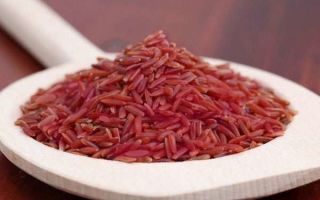Content
- 1 Description and types of red rice
- 2 Chemical composition of red rice
- 3 Nutritional value and calorie content of red rice
- 4 Benefits of red rice
- 5 What diseases does red rice help against?
- 6 Is red rice possible for diabetes
- 7 Red Rice Healing Recipes
- 8 The benefits and uses of sprouted red rice
- 9 The use of red rice in cosmetology
- 10 How to cook red rice
- 11 Harm of red rice and contraindications to use
- 12 Conclusion
Rice is one of the world's most popular cereals. It was domesticated about 9 thousand years ago, but in Russia it became known only in the 15th century, then it was called the "Saracen grain".
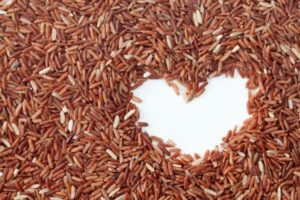
Now there are many varieties of this culture. In addition to the usual white rice grains, there is a huge assortment of other varieties on store shelves, among which there is even red rice. The benefits and harms of red rice will be discussed in the article.
Description and types of red rice
Polished rice varieties contain almost no useful elements and do not have properties valuable for health, while they can even cause harm. It is better to prefer unpolished types, they contain nutrients in greater quantities. Special processing allows you to preserve all the most valuable amino acids, minerals and vitamins, the properties of which are beneficial to humans. In addition, the shell of the grains gives the food a nutty aftertaste.
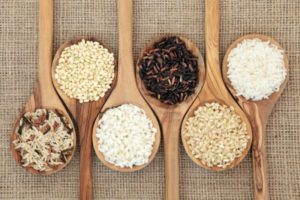
Most of the varieties have a round grain shape and various shades of red. Color differences are due to the methods of processing raw materials and their preparation. Residents of each country allocate for themselves a certain type of cereal, which is most popular in a particular region. Before purchasing red rice from the store, it is important to know what health benefits the different types have.
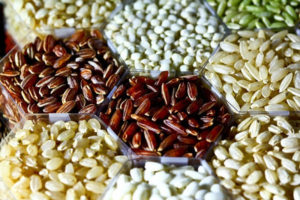
Now the most popular varieties of red rice are:
- California ruby. It has small grains. In unpolished form, they are bright burgundy. The shell of the grains contains a large amount of coarse fiber, which, passing through the intestine, cleans its walls. This property is of great benefit to the digestive tract and reduces the harm from food intake.
- Thai red rice, also called "cargo". Grains are burgundy in color, with a spicy nutty flavor. This category of rice contains a particularly large amount of nutrients. Groats are able to retain these beneficial properties even after processing. It contains a large amount of vitamins and antioxidants, which neutralize the harm from carcinogens and toxic substances.
- Short grain red rice. This type of cereal came from the south of France. It has a delicate, exquisite taste and an interesting property: the core of this rice is rich in minerals. It is useful for strengthening bones and teeth.
- Red yeast rice. Yeast mushrooms are used in its production. He is especially interested in medicine. It contains a large amount of plant statins, very useful substances that have the ability to regulate blood cholesterol, which is very harmful to health.
- Himalayan red rice. It has elongated grains of a special light pink color. After heat treatment, it acquires a sharp, rich taste. Used regularly by diabetics, it can lower blood sugar.
Chemical composition of red rice
This product is called elite for a reason: it has a truly unique chemical composition and many useful properties.
The benefits of red rice are due to the composition:
- vitamins B1, B2, B3 and B6;
- calcium, potassium and magnesium, phosphorus;
- iron, iodine;
- amino acids important for humans;
- large amounts of fiber and starch.
Nutritional value and calorie content of red rice
The calorie content of red rice per 100 grams is from 350 to 420 kcal. Therefore, a person who wants to lose weight should be very careful about this type of side dish, otherwise you can bring harm to the body instead of benefit.
Benefits of red rice
Red rice, its benefits and harms to health have long been the subject of controversy. At the same time, the beneficial properties of the grain cannot be counted. B-group vitamins are able to improve metabolic processes in the body, have properties useful for the nervous and circulatory systems, and benefit nails and hair.
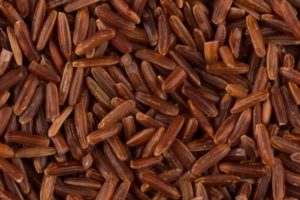
Magnesium neutralizes the harm from the external environment for the muscles and nerves of a person. Calcium in combination with magnesium is beneficial for bones and teeth, shows preventive properties against arthritis and osteoporosis. Iron is good for hemoglobin counts and can help reduce the harm from anemia. Fiber has beneficial cleansing properties and regulates the digestive tract. Unpolished red rice is beneficial for the intestines.
Why red rice is good for women
Regular inclusion of red rice in the diet will benefit women:
- Red rice has beneficial properties for the prevention of cancer. This is due to the large amount of antioxidants in the product, as well as selenium, zinc, copper, manganese, vitamins H, E and fiber. Together, they neutralize the harm from free radicals and promote the elimination of carcinogenic substances from the body.
- The nutritional properties of rice are also beneficial for a woman's reproductive system. Vitamin E and healthy fats have a stimulating effect on the production of sex hormones without causing harm.
- Consuming red rice helps to strengthen the nervous system and prevent insomnia. A large amount of B vitamins and magnesium in the composition are very useful for the nervous system of the fair sex.
- Red rice, due to the large amount of vitamins and antioxidants, as well as micro and macro elements, will be of great benefit to pregnant women. During lactation, the use of this product will benefit both the child and the mother.
The benefits of red rice for weight loss
Eating red rice will help reduce weight due to its ability to regulate metabolic processes, as well as the beneficial quality of rice to cleanse the body of substances that harm internal organs. At the same time, red rice is recommended in some diets.
In addition, rice helps to eliminate excess fluid. As you know, its accumulation harms the internal organs.
The benefit of this cereal culture is also in the ability to quickly and for a long time satisfy hunger, this property will help in gaining a slender figure.
What diseases does red rice help against?
Red rice in food has a lot of useful properties that help against various diseases, while there is no risk of harming other organs.
- In diabetes, it is beneficial to stabilize blood sugar levels. In addition, it benefits the blood vessels and helps to eliminate bad cholesterol.
- The large amount of iron in this cereal is a huge benefit for anemic individuals.
- Promotes the elimination of radionuclides, this beneficial property, combined with the powerful action of antioxidants, helps the cereal to help neutralize harm and prevent cancer.
- For problems with the gastrointestinal tract, red rice is also useful: fiber regulates digestion, neutralizes harm from toxins and food stagnation. Helps normalize beneficial microflora.
- For problematic vessels, eating red rice will benefit. Thanks to the beneficial properties of red rice, blood vessels are cleared of harmful cholesterol, strengthened and become more elastic.
- Red rice is very beneficial for diseases of the cardiovascular system and kidneys. The reduced amount of salts in the composition of this product, as well as the ability to remove excess fluid, will help get rid of substances that harm these organs.
Is red rice possible for diabetes
The use of cereals is recommended for diabetes, there will be no harm.
At the same time, it helps to normalize blood sugar levels, has the ability to remove harmful substances, and contains useful dietary fiber and antioxidants.
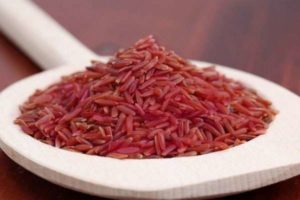
Red Rice Healing Recipes
The composition, rich in useful substances, the property of neutralizing the action of substances that harm the body, make this cereal very popular in various recipes.
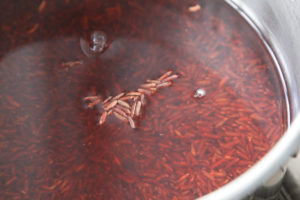
To cleanse the body of cholesterol, toxins and toxins
This interesting recipe helps cleanse the body of substances that harm various internal organs. The benefits of this recipe are invaluable. Rice must be used raw. It should be eaten on an empty stomach instead of breakfast. It is important to chew the portion thoroughly. It must first be soaked in water.
For a cleansing course, you need to take as many tablespoons of grains as the person lived for at the time of treatment.
- In the morning, the grains must be poured into a glass jar and filled with boiled water, and then refrigerated.
- The next morning, you need to drain the water.
- Chew 1 tablespoon red rice thoroughly and swallow.
- Then do not eat or drink for 2 hours.
- Rinse the remaining grains again, add boiled water and refrigerate.
- The course continues until the grains run out.
To improve the microflora of the large intestine
Rice milk porridge will help cleanse the digestive tract and normalize the amount of beneficial microflora, neutralize the harm from toxins and toxins.
- One glass of red rice should be soaked for an hour.
- Then drain the water and pour it into pre-boiled five glasses of milk.
- It is necessary to cook the cereals over low heat, covering with a lid, for about an hour, until the grains are boiled.
- Before serving, you can add a spoonful of honey or sugar to the serving.
Decoction of red rice for the treatment of infectious diseases
A decoction made from grains of red rice will be beneficial during an exacerbation of infections that affect the respiratory tract. The beneficial properties of such therapy will help to calm the fever and cleanse the body of toxins that are harmful to the patient.
He will be able to help even with angina, flu and pneumonia.
In addition, taking such a decoction will be beneficial for stomach ulcers, poisoning and diarrhea.
It will help with thirst, improve the condition of the skin, rejuvenate, improve complexion and remove freckles.
- For its preparation, it is necessary to pour thoroughly washed 100 grams of red rice with one and a half liters of cold water.
- Cook the resulting mixture without salt for an hour and a half over low heat.
- After it is required to strain.
- Take the resulting broth in a quarter of a glass half an hour before meals every 2-3 hours.
Infusion of red rice for osteochondrosis and rheumatism
To prepare the infusion, you must mix:
- liter of water;
- 4 tablespoons of red rice
- 5 pieces of raisins;
- 3 tablespoons of sugar.
The resulting mixture must be allowed to brew for four days. After strain and use the infusion for half a glass at night. The course lasts up to 3 months.
The benefits and uses of sprouted red rice
Sprouted grains of red rice, in addition to their usual beneficial properties, bring benefits to the body, endowing it with live energy. Sprouts are useful for their tonic properties, calming effect on the gastrointestinal mucosa, help normalize appetite, have a beneficial effect on diabetics, lower sugar, and help milk production during lactation.
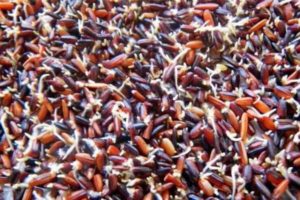
- To get red rice sprouts, pour the grains so that they are completely covered with water.
- A day later, the rice is washed, laid in one layer and again poured to half the grains.
- Cover the dishes with a lid and leave a small hole.
- Germination will begin in 6-7 hours. As it is absorbed, water is added, but only up to half the grain.
Such sprouts are edible in any form and in any dish. They are especially good in salads, soups, main courses. Sprouted grains can be stored in the refrigerator for no longer than 3 days.
The use of red rice in cosmetology
The beneficial properties of red rice are relevant not only for internal use, but also for external use. Cosmetics made on its basis will help to rejuvenate the skin, increase its elasticity and tone. The texture and properties of the grains make it possible to use red rice for peels, masks and other products that improve the appearance of the skin and, importantly, do not harm it.
Red rice mask for oily skin
- A small amount of rice must be ground into powder.
- Next, the rice powder is mixed with yogurt or yogurt to a thick sour cream.
- The product is applied to a previously cleansed face and stays on the skin for five minutes.
- Wash off with warm water.
This mask helps to normalize the work of the sebaceous glands, makes the skin dull and exfoliates dead skin particles.
Red rice mask for dry skin
Rice is ground into powder and mixed with olive or sea buckthorn oil. The consistency should be the same as in the previous recipe.
This mixture should be applied to the skin for 5-10 minutes, then rinsed with warm water.
This mask evens out the skin surface, improves the complexion, nourishes and moisturizes the epidermis. In addition, such a mask is beneficial in the form of massage of the epidermis.
How to cook red rice
Maintaining the health benefits of red rice in its preparation requires special care.
To cook red rice, you need to take 2–2.5 cups of boiling water per glass of cereal.
- Rice must first be sorted out and washed.
- Put the grains in a saucepan with a thick bottom and cover with boiling water, its level should be two fingers higher than the rice.
- Rice is put on fire and cooked over low heat for about half an hour.
- When the rice is done, no liquid should remain and the grains should be soft and tender.
- The side dish should stand for 5-10 minutes before serving.
This type of rice is especially good when combined with meat, fish, mushrooms, vegetables and dried fruits.
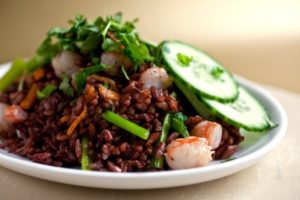
Harm of red rice and contraindications to use
Red rice varieties, when consumed in moderation, will provide the body with exceptional benefits.
But you shouldn't abuse it, and it's not even about its high calorie content. A large amount of red rice in the diet can cause disruptions in the gastrointestinal tract and weight gain.
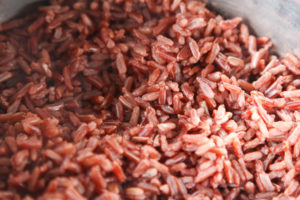
Conclusion
The benefits and harms of red rice are incomparable. The useful properties of this healing cereal can hardly be overestimated. Its scope is extremely extensive, and red rice, when used wisely, does not cause harm.

